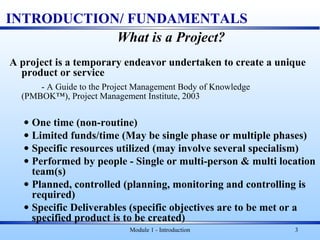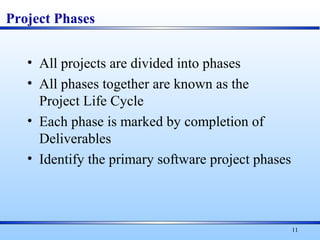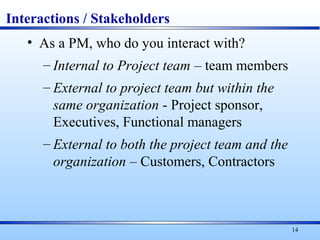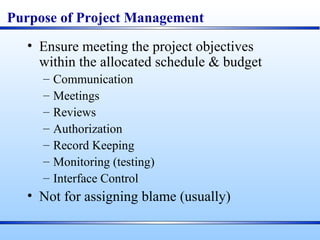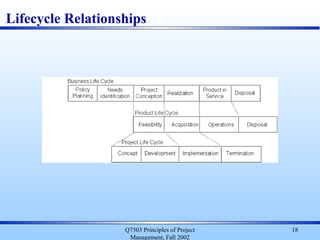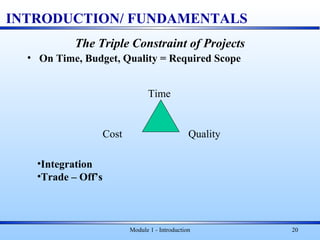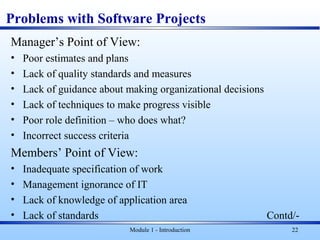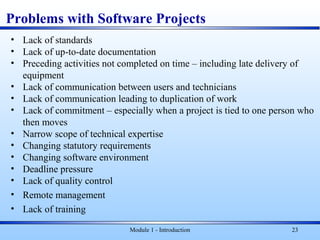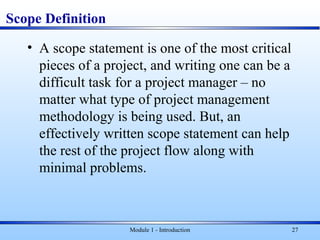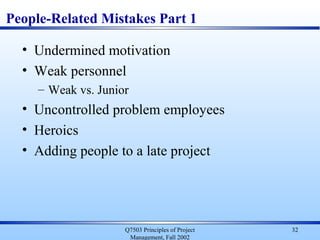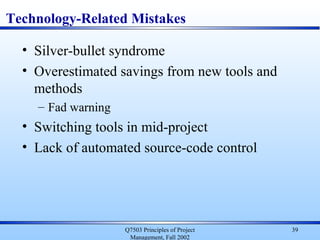Introduction to Software Project Management
- 2. The Two End Points in a Project Inspiration Operation A miracle occurs
- 3. Module 1 - Introduction 3 INTRODUCTION/ FUNDAMENTALS What is a Project? A project is a temporary endeavor undertaken to create a unique product or service - A Guide to the Project Management Body of Knowledge (PMBOK™), Project Management Institute, 2003 • One time (non-routine) • Limited funds/time (May be single phase or multiple phases) • Specific resources utilized (may involve several specialism) • Performed by people - Single or multi-person & multi location team(s) • Planned, controlled (planning, monitoring and controlling is required) • Specific Deliverables (specific objectives are to be met or a specified product is to be created)
- 4. Module 1 - Introduction 4 INTRODUCTION/ FUNDAMENTALS Characteristics of projects (From Bob Hughes and Cotterell) – addl points from exam point of view • Non-routine tasks are involved • Planning is required • Specific objectives are to be met or a specific product is to be created • The project has a predetermined time span • Work is carried out for someone other than yourself • Work involves several specialisms • People are formed into a temporary work group to carry out the task • Work is carried out in several phases • The resources that are available for use on the project are constrained • The project is large or complex
- 5. What is Management • Planning – deciding what is to be done • Organizing – making arrangements • Staffing – selecting right people for the job etc. • Directing - giving instructions • Monitoring – checking on progress • Controlling – taking action to remedy hold-ups • Innovating – coming up with new solutions • Representing – liaising with clients, users, developers, suppliers and other stakeholders. Module 1 – Introduction Bob Hughes, MikeCotterell and Rajib Mall 5
- 6. The Management Spectrum Effective project management focuses on four P’s (in the order): The People: Stakeholders, the team leaders, and the software team • Deals with the cultivation of motivated, highly skilled people and teams • Includes recruiting, selection, performance management, training, compensation, career development, organization and work design, and team culture development The Problem/ Product: before a project can be planned • Its objectives and scope should be established; • Alternative solutions should be considered; and • Technical and management constraints should be identified. The process: a software process provides the framework from which a comprehensive plan for software development can be established. The project: Planning and controlling a software project is done for one primary reason…it is the only known way to manage complexity Module 1 - Introduction 6
- 7. Q7503 Principles of Project Management, Fall 2002 7 Project Management Skills • Leadership • Communications • Problem Solving • Negotiating • Influencing the Organization • Mentoring • Process and technical expertise
- 9. 9 INTRODUCTION/ FUNDAMENTALS Software Project Management • Software project management is aimed to ensure that the software is delivered on time, within budget and schedule constraints, and satisfies the requirements of the client • Management of software projects is different from other types of management because: – Software is not tangible – Software processes are relatively new and still “under trial” – Larger software projects are usually “one-off” projects – Computer technology evolves very rapidly
- 10. 10 INTRODUCTION/ FUNDAMENTALS Software Projects versus other types of Projects • Invisibility – With physical artifacts, measuring progress is easy as it can be seen/ felt. However with Software, progress is not immediately visible. • Complexity – Software products are, generally, more complex than other engineering artifact of same value. • Flexibility - It is easier to change/ modify software systems to meet changing organizational/ product requirement as compared to other engineering artifacts; it may not be possible to modify a physical artifact at all.
- 11. 11 Project Phases • All projects are divided into phases • All phases together are known as the Project Life Cycle • Each phase is marked by completion of Deliverables • Identify the primary software project phases
- 12. Q7503 Principles of Project Management, Fall 2002 12 Seven Core Project Phases
- 13. Q7503 Principles of Project Management, Fall 2002 13 Project Phases A.K.A.
- 14. 14 Interactions / Stakeholders • As a PM, who do you interact with? – Internal to Project team – team members – External to project team but within the same organization - Project sponsor, Executives, Functional managers – External to both the project team and the organization – Customers, Contractors
- 15. Purpose of Project Management • Ensure meeting the project objectives within the allocated schedule & budget – Communication – Meetings – Reviews – Authorization – Record Keeping – Monitoring (testing) – Interface Control • Not for assigning blame (usually)
- 16. Module 1 - Introduction 16 Project Life Cycle 5% 20% 60% 15% Concept Planning Execution/Control Closing Percentages and graph refer to the amount of effort (people) In IT projects = 90-95% of cost! Definition | Analysis |Design|Build|Test|Accept| Implement| Operation INTRODUCTION/ FUNDAMENTALS Initiation or
- 17. Module 1 - Introduction 17 •Initiation – on the first stage, the necessity, feasibility, scope, time, budget and critical success factors of the project are defined along with the approach and methods to be used to deliver the required products and results. •Planning – this stage includes a detailed identification of all the project elements and matters including project team, specified allocation of project resources and timeline, assignments of project tasks, evaluation of risks, definition of criteria for quality and successful completion of each deliverable, etc. •Execution – this is the working phase where the project plan is implemented through practical actions that lead to successful project accomplishment. It is necessary to control performance and quality of all the required activities to know if they match the project’s requirements. •Closure – this stage identifies the project completion including testing, evaluation and formal acceptance of the final product by the customer, learning obtained from project experience, disposing resources, etc. Project Life Cycle
- 18. Q7503 Principles of Project Management, Fall 2002 18 Lifecycle Relationships
- 19. Q7503 Principles of Project Management, Fall 2002 19 Project vs. Program Management • What’s a ‘program’? • Mostly differences of scale • Often a number of related projects • Longer than projects • Definitions vary • Ex: Program Manager for MS Word
- 20. Module 1 - Introduction 20 INTRODUCTION/ FUNDAMENTALS The Triple Constraint of Projects • On Time, Budget, Quality = Required Scope Time Cost Quality •Integration •Trade – Off’s
- 21. Q7503 Principles of Project Management, Fall 2002 21 Trade-off Triangle • Know which of these are fixed & variable for every project
- 22. Problems with Software Projects Manager’s Point of View: • Poor estimates and plans • Lack of quality standards and measures • Lack of guidance about making organizational decisions • Lack of techniques to make progress visible • Poor role definition – who does what? • Incorrect success criteria Members’ Point of View: • Inadequate specification of work • Management ignorance of IT • Lack of knowledge of application area • Lack of standards Contd/- Module 1 - Introduction 22
- 23. Problems with Software Projects • Lack of standards • Lack of up-to-date documentation • Preceding activities not completed on time – including late delivery of equipment • Lack of communication between users and technicians • Lack of communication leading to duplication of work • Lack of commitment – especially when a project is tied to one person who then moves • Narrow scope of technical expertise • Changing statutory requirements • Changing software environment • Deadline pressure • Lack of quality control • Remote management • Lack of training Module 1 - Introduction 23
- 24. INTRODUCTION/ FUNDAMENTALS Assignment 1 Q1. What do you understand by Need identification, Vision and Scope for a product? Search on internet to find sample vision and scope document, copy the headings in your notebook and be prepared to present in the class –Group Activity – one per group. Q2. What is the Vision Statement of ABES EC? What is the difference between Vision Statement and Quality Policy of an Organization? – Individual work. Module 1 - Introduction 24
- 25. Vision Statement • A vision statement is sometimes called a picture of your company in the future but it’s so much more than that. Your vision statement is your inspiration, the framework for all your strategic planning. • A vision statement may apply to an entire company or to a single division of that company. Whether for all or part of an organization, the vision statement answers the question, “Where do we want to go?” Module 1 - Introduction 25
- 26. Vision Statement General Motors – Vision Statement "GM’s vision is to be the world leader in transportation products and related services. We will earn our customers’ enthusiasm through continuous improvement driven by the integrity, teamwork, and innovation of GM people." Module 1 - Introduction 26
- 27. Scope Definition • A scope statement is one of the most critical pieces of a project, and writing one can be a difficult task for a project manager – no matter what type of project management methodology is being used. But, an effectively written scope statement can help the rest of the project flow along with minimal problems. Module 1 - Introduction 27
- 28. Scope Definition The firsts step on writing a scope statement is filling in the project name, project charter, and a listing of the project owner, sponsors, and stakeholders. Next, A project justification will need to be identified, as well as project requirements, milestones, and deliverables. (In scope Items) Any non-goals - items that fall outside of the scope of the project - need to be identified here. And finally, cost estimates need to be provided within the scope statement. Note - This can be a cumbersome task, but it is a necessary one. As the project progresses, everyone involved knows where they can look should a question arise. Module 1 - Introduction 28
- 29. Questions? Module 1 - Introduction 29
- 30. Extra Slides Module 1 - Introduction 30
- 31. 31 Four Project Dimensions • People • Process • Product • Technology Q7503 Principles of Project Management, Fall 2002
- 32. Q7503 Principles of Project Management, Fall 2002 32 People-Related Mistakes Part 1 • Undermined motivation • Weak personnel – Weak vs. Junior • Uncontrolled problem employees • Heroics • Adding people to a late project
- 33. Q7503 Principles of Project Management, Fall 2002 33 People-Related Mistakes Part 2 • Noisy, crowded offices • Customer-Developer friction • Unrealistic expectations • Politics over substance • Wishful thinking
- 34. Q7503 Principles of Project Management, Fall 2002 34 People-Related Mistakes Part 3 • Lack of effective project sponsorship • Lack of stakeholder buy-in • Lack of user input
- 35. Q7503 Principles of Project Management, Fall 2002 35 Process-Related Mistakes Part 1 • Optimistic schedules • Insufficient risk management • Contractor failure • Insufficient planning • Abandonment of plan under pressure
- 36. Q7503 Principles of Project Management, Fall 2002 36 Process-Related Mistakes Part 2 • Wasted time during fuzzy front end • Shortchanged upstream activities • Inadequate design • Shortchanged quality assurance
- 37. Q7503 Principles of Project Management, Fall 2002 37 Process-Related Mistakes Part 3 • Insufficient management controls • Frequent convergence • Omitting necessary tasks from estimates • Planning to catch-up later • Code-like-hell programming
- 38. Q7503 Principles of Project Management, Fall 2002 38 Product-Related Mistakes • Requirements gold-plating – Gilding the lily • Feature creep • Developer gold-plating – Beware the pet project • Push-me, pull-me negotiation • Research-oriented development
- 39. Q7503 Principles of Project Management, Fall 2002 39 Technology-Related Mistakes • Silver-bullet syndrome • Overestimated savings from new tools and methods – Fad warning • Switching tools in mid-project • Lack of automated source-code control
- 40. Module 1 - Introduction 40 INTRODUCTION/ FUNDAMENTALS The Value of Project Management • Allows for excellent organization and tracking • Better control and use of resources • Reduces complexity of inter-related tasks • Allows measurement of outcome versus plans • Early identification of problems and quick correction
Editor's Notes
- #15: managing all stakeholder Expectations is challenging – conflict
- #17: This is the first introduction to how we approach the management of projects. This is from the PMBOK: Every project can be divided into 4 major phases: Concept where we document the original idea and get funding for the next phase. Planning where we detail the plan and get approval for the remainder. Execution (we do the work)/Control(we make sure everything follows the plan, react to problems, report progress) Closing where we document what went right and wrong, and close up. Note the line graph (and percentages) of effort expended. This is exactly the shape of the cost flow in an IT project, where 85-95% of the costs are people costs.
- #21: Classical definition of success is on time, budget, and does what the client expected it to do. However, must add to this: A happy team. The key stakeholder is your (the students’) team. Project management is rules, structure, discipline. May turn people off. Do not over do it. Similarly, be careful about over managing the contractor (part of your team). They must make their profit. A happy client. The client must be involved in the process (the team can’t just disappear and turn up six months later with the completed project). That is why we have phases, which provide milestones, intermediate deliverables, progress reports, reviews, etc. that the client must be involved in. Your upper level management (ULM) must also be happy: they also must be involved in the process. At your (PM) level, you will be communicating mostly with the client PM level of management. However, your ULM will be communicating with the client’s ULM, and you do not wish hassles coming down the hierarchy. (Case of the client complaining to his ULM, who goes to your ULM, who does not know about the project.)
- #32: Peopleware issues 10-to-1 difference in Dev productivity Teams 3 or 5 to 1 diff Process Dev basics, risk mgmt, QA, lifecycle planning, customer orientation Product Most tangible dimension Technology
- #33: Motivation: studies show has largest impact Don’t undermine Morale 2nd greatest influence on productivity Junior != bad Uncontrolled: most common developer complain about their managers Heroics. Company hostage. “Can-do”, “how high” attitudes Brooks, reading assignment
- #34: 60%of developers feel unsatisfactory environment: need quite and privacy MS offices Friction: classic differing viewpoints Results in ‘poor communication’ Passive-aggressive Realistic Expectations: 1 of top 5 reasons for success of in-house projects Perception woe Politics Managing-up Wishful Cognitive dissonance Closing your eyes and hoping McConnell: maybe causes the most problems in software development
- #35: Sponsor: a must, no power All players must buy-in User input: Survey: number 1 reason for success W/O input: guessing
- #36: Similar to wishful thinking Puts unnecessary pressure Risk Mgmt: Risks will manage you Contractor: late, poor quality, or fails to meet specifications Requires lots of management Insufficient planning: “if you don’t care where you’re going, any plan will do” Abandonment Out the window Fall into code-and-fix mode
- #37: fuzzy: before sign-off Upstream: Lack of analysis and design 10 to 100 times more costly 5 hrs vs. 50 Design: Seen schedules w/o it at all QA: Seems easy to compress 1 day QA == 3 to 10 later
- #38: Management controls Need to be able to track We’ll cover lots of these PMI Convergence Waste of time Missing tasks Often 20-30% of a schedule Catch-up later How many times have you seen a project catch-up? Only by all-nighters Like hell “Entrepreneurial” approach See catch-up later
- #39: Gold Gilding the lily Performance is required more often than need be Feature creep 25% average change in req. Dev. Gold Nifty new technology Pet project Push-me Slip schedule + add features Research vs. Development
- #40: who’s heard of ‘silver bullet’ (not the beer) SCM Jones: 10% month, I see more


